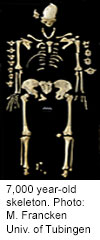- Navigating Your Midlife Crisis: Embracing New Possibilities
- City Raccoons Showing Signs of Domestication
- Mapping the Exposome: Science Broadens Focus to Environmental Disease Triggers
- One Week Less on Social Media Linked to Better Mental Health
- Your Brain Changes in Stages as You Age, Study Finds
- Some Suicide Victims Show No Typical Warning Signs, Study Finds
- ByHeart Formula Faces Lawsuits After Babies Sickened With Botulism
- Switch to Vegan Diet Could Cut Your Greenhouse Gas Emissions in Half
- Regular Bedtime Does Wonders for Blood Pressure
- Dining Alone Could Mean Worse Nutrition for Seniors
She Had Leukemia 7,000 Years Ago


Life in Europe’s Neolithic Age, more than 7,000 years ago, was never easy. But an examination of the remains of a woman from the period suggests she battled a foe still prevalent today — leukemia.
The 30- to 40-year-old woman, simply called G61, may be the oldest case of the blood cancer yet recorded, said a team of German scientists at the University of Tubingen’s Senckenberg Center for Human Evolution and Paleoenvironment.
According to the researchers, the woman’s skeleton was found alongside that of bones from 11 other people at a site in southern Germany. The excavations took place in the 1980s and early 1990s.
Lead researcher and paleoanthropologist Heike Scherf said a detailed CT-scan analysis of the woman’s bones point to leukemia. For example, the skeleton displayed “an unusual loosening of the interior bone tissue” that suggests the effects of blood cancer, Scherf said in a university news release.
This “loosening” occurred in certain areas of the skeleton that are home to blood-forming stem cells, Scherf explained. It is in these spots that leukemia can occur.
“None of the other specimens showed this significant pattern,” she said, “Even though they come from the same site and belong to the same age group.”
The researchers said life was tough in Germany 7,000 years ago, and harsh conditions left people vulnerable to nutritional deficiencies, infections and degenerative illnesses, including osteoporosis.
But Scherf’s team said it was able to rule out other possible causes of the bone irregularities, such as osteoporosis or thyroid disorders.
Still, even though there seems to be good evidence that the woman had a leukemia, scientists may never know whether she actually died from the illness, Scherf said.
More information
The U.S. National Cancer Institute has more about leukemia.
Source: HealthDay
Copyright © 2025 HealthDay. All rights reserved.










